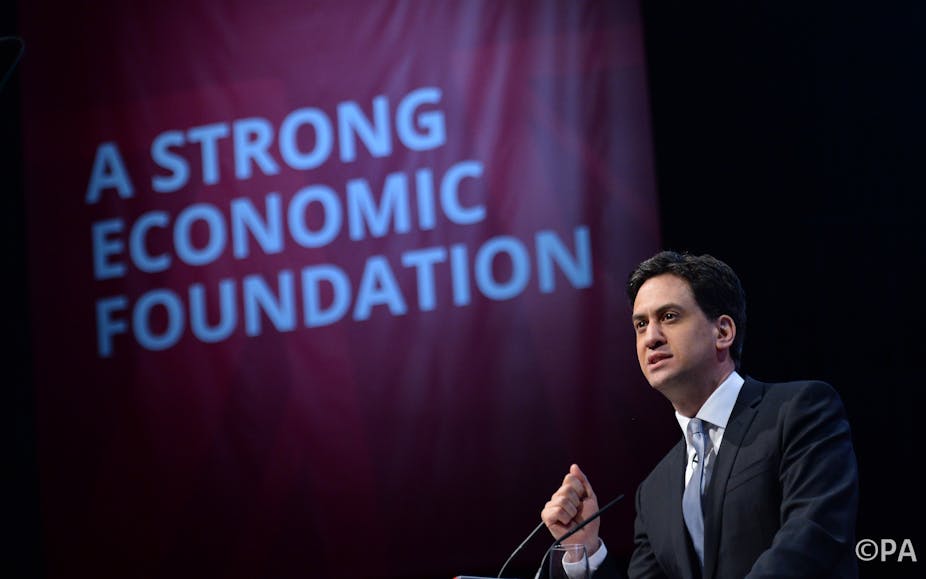Economy
Jonathan Perraton, Senior Lecturer in Economics at University of Sheffield
A key tenet of the Labour Party’s manifesto is the commitment to reducing the budget deficit year-on-year through the lifetime of the next parliament. The manifesto views the UK economy as exhibiting key structural weaknesses. These include poor productivity growth and a stagnation in living standards.
There are a range of measures designed to address this by attempting to raise productivity as well as targeting the cost of living. Although the point is not made explicitly, sustained growth is required for this programme to be achieved.
The deficit elimination challenge
Labour’s pledge not to raise the basic rate of income or corporation tax, VAT or National Insurance will make eliminating the budget deficit challenging. There are, though, clear differences between Labour’s proposals and those of the Conservatives and Liberal Democrats. The timescale for eliminating the deficit is longer and Labour has still allowed itself room to borrow to finance investment – how much remains unclear.
In other respects there are strong similarities between Labour’s proposals and those of the coalition partners. The same key budgets are ring-fenced – health, education and foreign aid (though Labour includes higher and further education whereas the Conservatives appear only to be ring-fencing the schools budget). Incidentally, the aid budget is tiny, at around 1.4% of government expenditure.
This means that cuts – the Labour manifesto explicitly uses the term – would have to fall on those departmental budgets that have already borne the brunt of these under the coalition. There is an explicit commitment to cap the welfare budget. Although winter fuel payments would be ended for wealthier pensioners, as with the coalition, the burden would fall on working age benefits. This is partly linked to other measures to help workers – raising the minimum wage and promoting the living wage should reduce working tax credits and promoting house building should help to reduce the housing benefits bill.
Although Labour makes a concerted attempt to cost its commitments and indicate how they would be funded, questions remain. Cost savings, closing tax loopholes and clamping down on tax evasion are measures that governments regularly propose, but it isn’t clear that they would be sufficient.
Achieving growth
More fundamentally, governments do not determine the budget deficit – contrary to the impression given by much of the media and indeed politicians. Governments do set tax rates and expenditure plans, but the deficit (or surplus) is ultimately determined by growth in the economy.
The Labour manifesto recognises that growth, and rising incomes leading to more tax receipts, will eliminate the deficit. A series of measures are proposed for this, in particular a guarantee of apprenticeships for suitably qualified school leavers and introducing a British Investment Bank and regional banks together with measures to reform the financial system to promote longer term investment.
Historically the British economy has shown weaknesses in investment and in skills, particularly among non-graduates. Since the start of the financial crisis productivity and real wages have stagnated in the UK. Productivity is only likely to rise with higher investment and improved skills. Addressing the medium-run weaknesses of the British economy here is therefore desirable.
This is against a background of a dearth of profitable investment opportunities in advanced economies. Companies will only invest if they believe demand for their products will materialise – something that would be hampered by continued austerity.
Banking and finance
Rosa Lastra, Professor of International Financial and Monetary Law at Queen Mary University of London
The Labour Party manifesto promises to improve the access to credit for many small and medium-sized enterprises (SMEs). They have suffered in the aftermath of the financial crisis, finding it difficult to get the financing they need to invest and grow their business. An added problem for SMEs is the lack of an alternative to traditional bank lending.
Labour promises to establish a British Investment Bank with the mission to help businesses grow, to create wealth and jobs and to address the long standing problems in infrastructure investment. How this will be funded and structured (as it aspires to support a network of regional banks) will determine its potential success (or failure).
As Nick Tott, author of the report making the case for a British Investment Bank argues, it should operate in a commercial manner and all lending should be in addition to, or in partnership with, private lending. Regarding the desirability of a government-backed institution for SMEs, he points out that they exist in all other G8 countries.
Labour also plans to address the relative lack of competition in the banking market. This follows the results of the inquiry of the Independent Commission on Banking, which identified that the four largest banks account for 85% of SME current accounts.
They want to pave the way for the introduction of at least two new challenger banks. Labour also want to find alternatives to payday lenders possibly via the development of credit unions. Competition in banking should certainly be welcome as a way to address the perverse incentives of too-big-to-fail institutions.
All political parties should be rightly concerned about the rise in inequality, with a large number of people living with low wages as well as increasing anxiety about the capacity of pensions to avert old age poverty. Thomas Piketty, the French economist feted for his work Capital in the Twenty First Century, has contributed to bringing the issues of inequality to the forefront of economic and policy debate.
The Conversation’s Manifesto Check deploys academic expertise to scrutinise the parties’ plans.

